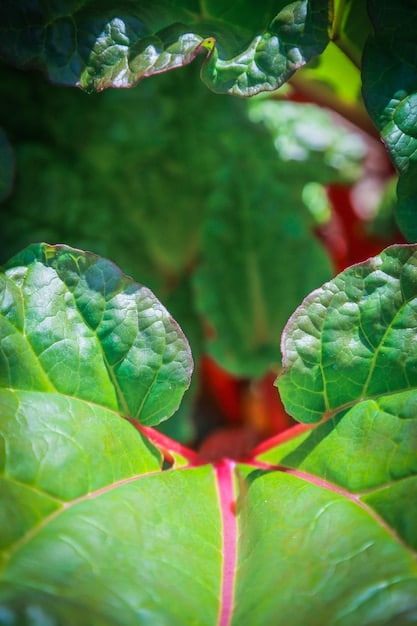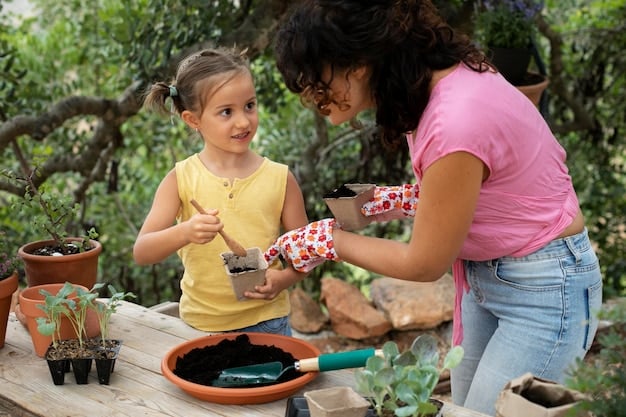Latest Federal Grants for Community Gardens in 2025: A Comprehensive Guide

Discover the latest federal grants available for community garden initiatives in 2025, offering vital funding opportunities to support sustainable food systems, enhance community engagement, and promote environmental stewardship across the United States.
Are you passionate about fostering community connections through gardening? Securing funding is crucial to transform your vision into a thriving reality. Let’s explore what are the latest federal grants available for community garden initiatives in 2025, empowering communities to cultivate green spaces and promote sustainable practices.
Understanding Federal Grants for Community Gardens
Federal grants play a vital role in supporting community garden initiatives across the nation. These grants can provide the necessary funding for various aspects of garden development and maintenance, from purchasing tools and seeds to implementing educational programs and building infrastructure.
Navigating the world of federal grants can be challenging, but understanding the types of grants available and eligibility requirements is the first step toward securing the funding your community garden needs.
Types of Federal Grants
Several federal agencies offer grants that can be used to support community garden initiatives. These grants often fall into categories such as:
- Environmental Grants: Focus on promoting sustainable practices and environmental stewardship.
- Agricultural Grants: Support local food production and community engagement.
- Community Development Grants: Aim to improve the quality of life in underserved communities.
Eligibility Requirements
Each grant program has specific eligibility requirements that applicants must meet. Common requirements include:
- Nonprofit Status: Many grants are only available to registered nonprofit organizations.
- Community Involvement: Demonstrating strong community support and involvement is crucial.
- Project Sustainability: Having a plan for the long-term sustainability of the garden is essential.

By understanding the different types of federal grants available and the eligibility requirements, you can better position your community garden to receive funding and make a positive impact on your community.
Key Federal Agencies Offering Garden Grants
Identifying the key federal agencies that offer grants for community gardens will help you narrow your search and focus your efforts on the most relevant opportunities. These agencies are committed to supporting community-led initiatives that promote health, sustainability, and community development.
Here are some of the primary agencies to consider:
U.S. Department of Agriculture (USDA)
The USDA offers several grant programs that can support community gardens, including:
- Community Food Projects Competitive Grants Program: Supports projects that increase access to fresh, healthy food in low-income communities.
- Farmers Market Promotion Program: Provides funding for projects that promote farmers markets and local food systems.
Environmental Protection Agency (EPA)
The EPA offers grants that focus on environmental education and sustainable practices, which can be relevant to community gardens:
- Environmental Education Grants: Supports projects that educate the public about environmental issues and promote sustainable solutions.
Department of Health and Human Services (HHS)
HHS offers grants that address health disparities and promote healthy lifestyles, including:
- Community Transformation Grants: Supports community-led initiatives that promote healthy behaviors and prevent chronic diseases.
By exploring the grant opportunities offered by these key federal agencies, you can identify potential sources of funding for your community garden and increase your chances of securing the resources you need to succeed.
Spotlight on 2025 Grant Opportunities
Staying informed about specific grant opportunities is essential for maximizing your chances of securing funding for your community garden. As 2025 approaches, it’s crucial to monitor federal agency websites and grant databases for the latest announcements and updates.
Here are some potential grant opportunities to watch out for in 2025:
Community Food Projects Competitive Grants Program (USDA)
This program provides funding to support projects that address food insecurity and promote access to healthy food in low-income communities. Community gardens can be eligible for funding to support activities such as:
- Building raised beds and garden infrastructure
- Providing gardening education and training
- Distributing fresh produce to local food banks and residents
Environmental Education Grants (EPA)
The EPA’s Environmental Education Grants support projects that educate the public about environmental issues and promote sustainable practices. Community gardens can utilize these grants to fund:
- Workshops on organic gardening and composting
- Educational signage and interpretative displays
- Community outreach and engagement activities
Local Food Promotion Program (USDA)
This program helps to improve and expand local and regional food systems. Community gardens can use these funds to:
- Expand community garden capacity
- Increase volunteer participation
- Improve community access and engagement

By researching and identifying specific grant opportunities that align with your community garden’s goals and objectives, you can develop compelling grant proposals that have a strong chance of success.
Crafting a Compelling Grant Proposal
Writing a strong grant proposal is crucial to securing funding for your community garden. A well-written proposal should clearly articulate your project’s goals, methods, and expected outcomes, and demonstrate its potential impact on the community.
Here are some key steps to crafting a compelling grant proposal:
Clearly Define Your Project Goals
Your proposal should start by clearly defining the goals and objectives of your community garden project. What specific needs will your garden address? What outcomes do you hope to achieve?
- Increase access to fresh, healthy food for low-income residents
- Provide educational opportunities about gardening and nutrition
- Create a gathering place for community members to connect and socialize
Describe Your Project Methods
Explain how you plan to achieve your project goals. Describe the specific activities and strategies you will use, such as:
- Building raised beds and installing irrigation systems
- Providing gardening workshops and training sessions
- Partnering with local organizations to distribute produce
Highlight Your Community Impact
Emphasize the potential impact of your community garden on the community. How will your project benefit residents? How will it contribute to community development?
- Improved food security and nutrition
- Increased community engagement and social cohesion
- Enhanced environmental awareness and sustainability
By following these steps and crafting a well-written grant proposal, you can increase your chances of securing the funding your community garden needs to thrive and make a positive impact on your community.
Sustaining Your Community Garden Beyond the Grant
Securing a grant is a significant achievement, but it’s essential to plan for the long-term sustainability of your community garden beyond the initial grant funding. Developing diverse funding streams and building strong community support are crucial for ensuring the garden’s continued success.
Here are some strategies for sustaining your community garden:
Diversify Your Funding Sources
Don’t rely solely on grant funding. Explore other potential sources of income, such as:
- Selling produce at local farmers markets
- Hosting fundraising events and workshops
- Soliciting donations from local businesses and residents
Build Strong Community Partnerships
Cultivate relationships with local organizations, businesses, and government agencies. These partnerships can provide valuable resources, expertise, and support for your community garden.
- Partner with local schools to provide gardening education
- Collaborate with food banks to distribute produce to those in need
- Work with city government to secure in-kind support and resources
Engage Volunteers and Build a Strong Support Base
Volunteers are the heart of any successful community garden. Recruit and retain volunteers by:
- Providing meaningful opportunities to contribute
- Recognizing and appreciating their efforts
- Creating a welcoming and inclusive environment
By implementing these strategies and building a strong foundation of community support, you can ensure the long-term sustainability of your community garden and its continued positive impact on the community.
Resources for Finding and Applying for Grants
Navigating the world of grants can be challenging, but numerous resources can help you find and apply for funding opportunities for your community garden. These resources provide valuable information, guidance, and support to help you succeed in your grant-seeking efforts.
Here are some key resources to explore:
Grants.gov
Grants.gov is the official website for finding and applying for federal grants. It provides a comprehensive database of grant opportunities from across all federal agencies.
Foundation Center
The Foundation Center is a leading source of information on philanthropy and grantmaking. It offers a wealth of resources, including databases of grantmakers, training programs, and publications.
Local Community Foundations
Many communities have local foundations that provide grants to nonprofit organizations. Research local foundations in your area to identify potential funding opportunities.
University Extension Programs
University extension programs often offer resources and support for community garden initiatives. Contact your local extension office to learn about available programs and services.
By utilizing these resources and seeking guidance from experienced grant writers, you can increase your chances of finding and securing the funding your community garden needs to thrive and make a lasting impact on your community.
| Key Point | Brief Description |
|---|---|
| 🌱 Federal Grant Importance | Vital for funding community gardens, enhancing sustainability and community engagement. |
| 🏛️ Key Federal Agencies | USDA, EPA, and HHS offer grants for food projects, environmental education, and health initiatives. |
| 📝 Grant Proposal Tips | Clearly define goals, describe methods, and highlight community impact in applications. |
| 🤝 Sustaining Gardens | Diversify funding, build partnerships, and engage volunteers for long-term success. |
Frequently Asked Questions
▼
Federal grants often support projects focused on improving access to fresh food, providing educational programs, enhancing community engagement, and promoting environmental sustainability through community gardens.
▼
Eligibility often includes nonprofit status, proven community involvement, clear project goals, and detailed plans for long-term sustainability. Specific requirements can vary depending on the granting agency and program.
▼
Demonstrate impact by showcasing improved food access, enhanced community engagement, educational outcomes, and environmental benefits. Data, testimonials, and clear metrics in the grant proposal strengthen the impact narrative.
▼
Avoid unclear project goals, unrealistic budgets, demonstrating weak community support, neglecting to meet eligibility requirements, and failing to articulate the unique value and community impact of the garden.
▼
Diversify funding sources through fundraising, produce sales, and community events. Build partnerships with local organizations, engage regular volunteers, and seek in-kind support to ensure sustainability beyond grant funding.
Conclusion
Securing funding for community garden initiatives opens doors to fostering sustainable food systems and vibrant community connections. By understanding the landscape of available federal grants and focusing on the potential positive impacts your community garden can have, you empower your local community to cultivate something green.





